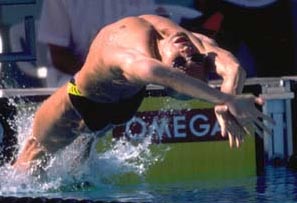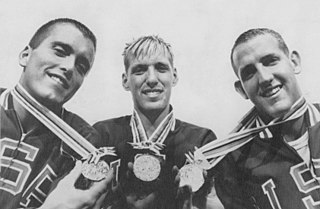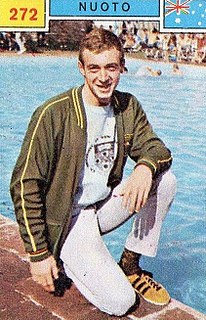
The men's 100 metre freestyle event at the 1976 Summer Olympics took place between July 24 and 25. This was the first time in history that the 100m freestyle was swum under 50 seconds. There were 41 competitors from 27 nations. Nations had been limited to three swimmers each since the 1924 Games. The event was won by Jim Montgomery of the United States, the nation's second consecutive and tenth overall victory in the men's 100 metre freestyle. His countryman Jack Babashoff took silver. Peter Nocke's bronze was the first medal for West Germany in the event, though the United Team of Germany had won a bronze in 1964.
The men's 100 metre backstroke was one of six swimming events on the swimming at the 1908 Summer Olympics programme. It was the only backstroke event on the schedule. It was the first appearance of the event, after a 100-yard event was held in 1904. The competition was held on Thursday July 16, 1908 and on Friday July 17, 1908.

The men's 200 metre backstroke event at the 1992 Summer Olympics took place on 28 July at the Piscines Bernat Picornell in Barcelona, Spain. There were 44 competitors from 34 nations. Each nation had been limited to two swimmers in the event since 1984. The event was won by Martín López-Zubero of Spain. Vladimir Selkov of the Unified Team took silver, while Stefano Battistelli of Italy earned bronze. It was the first medal in the men's 200 metre backstroke for each nation.

The men's 200 metre backstroke event at the 2000 Summer Olympics took place on 20–21 September at the Sydney Olympic Park Aquatic Centre in Sydney, Australia. There were 45 competitors from 38 nations. Each nation had been limited to two swimmers in the event since 1984. The event was won by Lenny Krayzelburg of the United States, with his countryman Aaron Peirsol taking silver. It was the second consecutive Games that Americans had finished one-two in the event. Bronze went to Matt Welsh of Australia, the nation's first medal in the event since 1980.

The men's 200 metre backstroke event at the 1984 Summer Olympics was held in the Uytengsu Aquatics Center in Los Angeles on July 31, 1984. There were 34 competitors from 25 nations, with each nation limited to two swimmers. The event was won by Rick Carey of the United States, the nation's third victory in the men's 200 metre backstroke. Frédéric Delcourt of France took silver and Cameron Henning of Canada earned bronze; it was the first medal in the event for each of those two nations.

The men's 100 metre freestyle event at the 1980 Summer Olympics was held on 26 and 27 July at the Swimming Pool at the Olimpiysky Sports Complex. There were 39 competitors from 26 nations. Nations had been limited to three swimmers each since the 1924 Games. The event was won by Jörg Woithe of East Germany, the nation's first medal in the men's 100 metre freestyle. Sweden earned its first medals in the event since 1952 with Per Holmertz's silver and Per Johansson's bronze.
The women's 400 metre individual medley event at the 2009 Maccabiah Games took place on 20 July at the Wingate Institute. This swimming event used medley swimming. Because an Olympic size swimming pool is 50 metres long, this race consisted of eight lengths of the pool. The first two lengths were swum using the butterfly stroke, the second pair with the backstroke, the third pair of lengths in breaststroke, and the final two were freestyle. Unlike other events using freestyle, swimmers could not use butterfly, backstroke, or breaststroke for the freestyle leg; most swimmers use the front crawl in freestyle events anyway.
The Women's 100 metre freestyle event at the 2009 Maccabiah Games took place on 19 July at the Wingate Institute. This swimming event used freestyle swimming, which means that the method of the stroke is not regulated. Nearly all swimmers use the front crawl or a variant of that stroke. Because an Olympic size swimming pool is 50 metres long, this race consisted of two lengths of the pool.
The men's 100 metre backstroke event at the 2009 Maccabiah Games took place on 9 July, at the Wingate Institute. This swimming event used the backstroke. Because an Olympic size swimming pool is 50 metres long, this race consisted of two lengths of the pool.
The men's 100 metre backstroke event at the 2005 Maccabiah Games took place on 13 July, at the Wingate Institute. This swimming event used the backstroke. Because an Olympic size swimming pool is 50 metres long, this race consisted of two lengths of the pool.
The men's 200 metre backstroke event at the 2005 Maccabiah Games took place on 10 July, at the Wingate Institute. This swimming event used the backstroke. Because an Olympic size swimming pool is 50 metres long, this race consisted of four lengths of the pool.
The women's 200 metre backstroke event at the 2005 Maccabiah Games took place on 10 July, at the Wingate Institute. This swimming event used the backstroke. Because an Olympic size swimming pool is 50 metres long, this race consisted of four lengths of the pool.
The women's 400 metre freestyle event at the 2005 Maccabiah Games took place on 13 July at the Wingate Institute. This swimming event used freestyle swimming, which means that the method of the stroke is not regulated. Nearly all swimmers use the front crawl or a variant of that stroke. Because an Olympic size swimming pool is 50 metres long, this race consisted of eight lengths of the pool.
The men's 100 metre breaststroke event at the 2005 Maccabiah Games took place on 13 July at the Wingate Institute. This swimming event used the breaststroke. Because an Olympic size swimming pool is 50 metres long, this race consisted of two lengths of the pool.
The women's 400 metre individual medley event at the 2005 Maccabiah Games took place on 11 July at the Wingate Institute. This swimming event used medley swimming. Because an Olympic size swimming pool is 50 metres long, this race consisted of eight lengths of the pool. The first two lengths were swum using the butterfly stroke, the second pair with the backstroke, the third pair of lengths in breaststroke, and the final two were freestyle. Unlike other events using freestyle, swimmers could not use butterfly, backstroke, or breaststroke for the freestyle leg; most swimmers use the front crawl in freestyle events anyway.
The men's 400 metre individual medley event at the 2005 Maccabiah Games took place on 11 July at the Wingate Institute. This swimming event used medley swimming. Because an Olympic size swimming pool is 50 metres long, this race consisted of eight lengths of the pool. The first two lengths were swum using the butterfly stroke, the second pair with the backstroke, the third pair of lengths in breaststroke, and the final two were freestyle. Unlike other events using freestyle, swimmers could not use butterfly, backstroke, or breaststroke for the freestyle leg; most swimmers use the front crawl in freestyle events anyway.

The men's 100 metre freestyle event at the 1952 Summer Olympics took place between 26 and 27 July at the Helsinki Swimming Stadium. There were 61 competitors from 33 nations. Nations had been limited to three swimmers each since the 1924 Games. The event was won by Clarke Scholes of the United States, the nation's second consecutive and seventh overall victory in the men's 100 metre freestyle. Japan, absent from the 1948 Games after World War II, returned to the podium in the event with Hiroshi Suzuki's silver. Göran Larsson earned Sweden's first medal in the event since 1908 with his bronze.

The men's 100 metre freestyle event at the 1956 Olympic Games took place between 29 and 30 November. There were 34 competitors from 19 nations. Nations had been limited to three swimmers each since the 1924 Games. The event was won by Jon Henricks of Australia, the nation's first medal in the event. Australia would win a second 0.4 seconds later and a third 0.9 seconds after that, sweeping the podium—the first sweep in the men's 100 metre freestyle since the United States did it in 1920 and 1924, and the first sweep of any event by Australian competitors. This year, the Americans finished fourth through sixth. It was the first time since 1924 that Japan had competed but not medaled.

The men's 200 metre backstroke event at the 1964 Summer Olympics took place between October 11 and 13. There were 34 competitors from 21 nations, with each nation having up to 3 swimmers. The medals were swept by the United States, with Jed Graef, Gary Dilley, and Bob Bennett taking gold, silver, and bronze respectively.

The men's 100 metre freestyle event at the 1968 Olympic Games took place between 18 and 19 October. There were 64 competitors from 34 nations. Nations had been limited to three swimmers each since the 1924 Games. The event was won by Michael Wenden of Australia, the nation's third victory in four Games. Americans Ken Walsh and Mark Spitz took silver and bronze, respectively.









